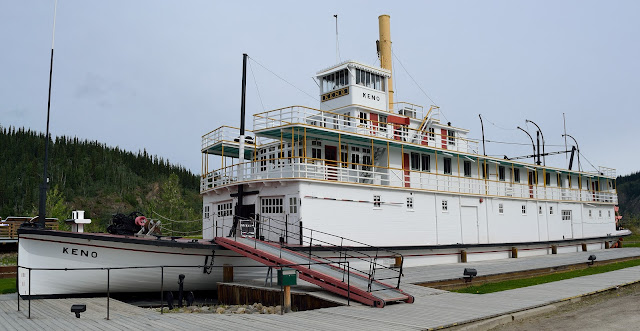After three wonderful days in Dawson, it was time to move on. Our next destination is Chicken, Alaska. But first we have to conquer “Top of the World Highway”. We left Dawson around 8:30 and headed for the ferry. The Yukon government operates a free ferry across the Yukon River called the “George Black”. The ferry is seasonal, it usually starts mid-May and stops mid-October depending on spring break-up and fall freeze-up. The ferry operates 24 hours a day 7 days a week. It shuts down for two hours on Thursdays between 5 – 7 am for servicing.
Ted and Bev had to diesel up so they left early and got to the ferry before us. We watched them cross then it was our turn.
There was quite a dip in the road to get on and off the ferry. Once we got over that it was clear sailing to the other side. The whole ride took 10 minutes and that included loading and unloading. As we crossed the river, looking back at downtown Dawson, the view was amazing.
As soon as you are clear of the ferry ramp the road starts a steady climb for 14km or 8 miles. Most of the grade is between 7 – 9 percent uphill climb. This portion of the road is paved with very few potholes. Once we all got to the top there’s a parking area. We stopped to take in the moment.
Within a km of leaving the rest area we ran into our first dirt road which was hard packed and had very few potholes. Not bad at all. It’s a beautiful sunny day, no rain all is good.
No sooner I said about the rain we could see rain closing in on us. When we were in Dawson all these vehicles would be coming into the campground absolutely covered in dirt and mud. I thought they were on the Dempster Hwy. Wrong, they came from this very road. It started to rain and within 5 minutes my truck and rig looked like everyone else’s. The problem is the road gets quite narrow and extremely slippery when it rains. To compound that the shoulders are soft, there’s no guardrails, and you’re trying to avoid potholes and washboard.
If that wasn’t bad enough, we climbed so high there was snow still on the side of the road. I kept reminding Susan that if we went off the road we would not stop until we hit the river below. Which is a long, long way down. I won’t tell you what she said back to me.

We stopped at the 87 km or 54 mile marker just to catch our breath. The Top of The World Highway is really two highways, the Yukon Hwy 9 in Canada and the Taylor Highway 5 in Alaska. As we were stretching our legs we noticed an old fallin’ down log house. If walls could talk. This old sod-roofed cabin was the supply and stopping place for a transportation company. The views from way up here were spectacular. Just to give another perspective Dawson elevation is 320 metres or 1,050 feet. The highest point we reached on the highway is 1,376 metres or 4,515 feet. Virtually all the Top of the World Highway runs above the tree line. The only civilization that you run into is at the border crossing. If you have vehicle problems it will take a long time to get help.



As we came around a curve we saw the border crossing. Civilization or we thought. The U.S. & Canada Customs is at 105.7 km or 65.7 miles. Three people are stationed at this crossing, two on the Canadian side and one on the US side. The US customs guard was really nice. The only thing they took was my oranges which happened to be a product of Spain. We waited down the road for the others to pass customs. And again the view was amazing. It has taken us over two and a half hours to travel 65 miles. Their Welcome to Alaska sign must have blown down in the winter. It’s too hard and probably too costly to get equipment up here to right it.
As we leave the border crossing we are a little spoiled. The road is beautifully paved. That was short lived as it turned to gravel and pot holes...again. We come to Jack Wade Junction, go to the right and the road takes you to Eagle, AK. Go to the left and your headed for Chicken, AK. That is where we are headed.
We continued on for another half hour then it was time for a bathroom break. The road is somewhat paved but not really. There are large pot holes and dips from frost heaves not to mention the hairpin turns, no shoulders or guardrails.
We came around a curve and sure enough there it was, the community, town, or whatever you want to call it ...Chicken, AK.
There are two campgrounds in Chicken, each offering something a little different. We chose to stay at Chicken Gold Camp & Outpost.
Even though this area is extremely remote, more and more travellers are daring the Top of the World Highway. Two large caravans pulled out of the campground just prior to us arriving. Just to put it into perspective, there is no city water, sewer, or electric service. There is no cell service way up here. We had 20 amp electric service at our site and that was generated from large diesel generators. It was the best 20 amp service I have ever had. So, why Chicken. I'm still asking myself that same question.


























































